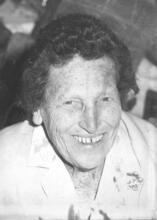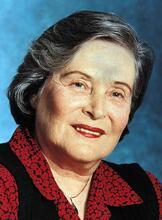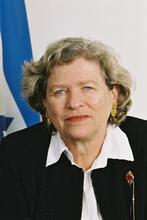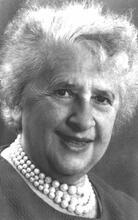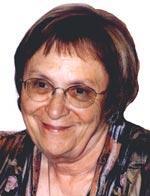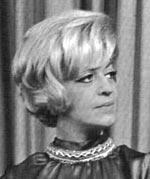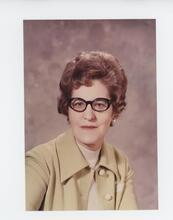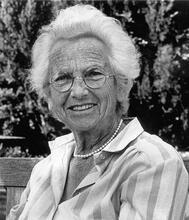Estera Tenenbaum
Estera Tenenbaum, who went on to become a prominent cell and virus scientist, was born in Warsaw in 1904. In 1929, after being educated in Berlin, she was appointed assistant at the Kaiser Wilhelm Institute for Brain Research, where she became a successful researcher on an international team studying genetics. In 1934 Tenenbaum was forced to leave Germany and join her family in Palestine. In 1936 she found work as a laboratory assistant at Hebrew University, and in 1951 she became an Instructor, receiving a grant to serve as a guest scholar at universities in England and France. When it became clear that the United States was the new frontier for groundbreaking developments in genetics and microbiology, Tenenbaum traveled to California and worked at the California Institute of Technology from 1955 until 1957, carrying out experiments on brain tissues in vitro. In 1959 she was appointed Lecturer in Experimental Pathology at Hebrew University.
Biologist Estera (Esther) Tenenbaum, who began her career in Germany, became prominent in cell and virus research after her enforced departure into exile.
Education & Research at the Kaiser Wilhelm Institute
Estera Tenenbaum was born on January 27, 1904, in Warsaw (Poland, at that time part of Imperial Russia), to a middle-class Jewish family with several children. The family later moved to Lodz, where Estera received an excellent education at a gymnasium. From 1921 until 1923 she studied science at the university in Krakow, but the antisemitism prevalent in Poland led her to continue her studies in Germany. Her parents and her younger brother emigrated from Poland to Palestine in 1924. From 1923 until 1929, Estera Tenenbaum studied biology and zoology at the University of Berlin, where she wrote her thesis under Richard Hesse (1868–1944).
In July 1929, thanks to her fellow student Marthe Vogt (b. 1903), who practiced medicine and, later, biochemistry, Tenenbaum was appointed assistant at the famous Kaiser Wilhelm Institute (KWI) for Brain Research in Berlin Buch (a district in the north of Berlin), where the directors were Marthe’s parents, Cécile (1875–1962) and Oskar Vogt (1870–1959). Here she worked in the department of genetics under Nikolaj Vladimirovich Timoféeff-Ressovsky (1900–1981), where the language used in the laboratory was Russian and her colleagues were the Russian-Soviet zoologist Sergej R. Zarapkin (1892–1958), the geneticist Elena (Helene) A. Timoféeff-Ressovsky (1898–1973), and a number of technical assistants such as Natalie Kromm (b. 1911). Tenenbaum studied the ladybird (Epilachna chrysomelina), discovering a genetic manifestation that influenced the spots on the insect’s wings. She published the initial results of her research in 1931 in the respected journal Die Naturwissenschaften (Natural Science) and became a successful researcher in Timoféeff-Ressovsky’s international team. Her major work was on tissue cultures infected with viruses.
Emigration to Palestine
When the Nazis came to power in 1933 the KWI for Brain Research came under severe attack, with demands to dismiss all foreigners, all Jews, and also women. Estera Tenenbaum was attacked on all three grounds. With the help of Nikolaj Timoféeff-Ressovsky and Oskar Vogt, she was able to get a grant for one year from the Rockefeller Foundation, but in 1934 she was forced to leave the institute and the country.
Since her parents and her beloved brother Yehuda Arazi (1907–1959) lived in Palestine, Tenenbaum went through Poland to Tel Aviv, where her parents supported her for a year until, in the spring of 1935, she found suitable scientific employment at the Institute for Agricultural Research in Rehovot. In 1936 she found work at the Hebrew University in Jerusalem, first as a laboratory assistant with a group researching several methods of growing plants, then as a junior assistant. In 1940 she became a Departmental Assistant and in 1951 an Instructor. In 1959 she was appointed Lecturer in Experimental Pathology.
Estera (or Esther, as she now called herself) Tenenbaum next found work under Jack Gross (d. 1994), in the Department of Experimental Medicine and Cancer Research of the Faculty of Medicine at the Hebrew University, cooperating closely with the Hadassah Medical School.
Research in Europe & the United States
In Autumn 1951, having received a grant to serve as guest scholar at various institutions in Great Britain and France, she worked in Paris, London, Cambridge, and Edinburgh. In Edinburgh she met her old friend Marthe Louise Vogt, who had moved to Britain in 1935 and been naturalized in1947. It became clear that she needed to go to the United States, where the most up-to-date developments in genetics and microbiology were taking place. In 1955 she travelled to the US, where she stayed from the autumn of 1955 until March 1957, working at the California Institute of Technology in Pasadena under Renato Dulbecco (b. 1914) and carrying out experiments on brain tissues in vitro. Here she met Max Delbrück (1906–1981) and became a friend of the younger daughter of the Vogts, Marguerite (b. 1913), who was also working at the Institute.
Esther Tenenbaum never married. She died in Jerusalem in 1963, following a myocardial infarction.
Selected Works
“Beiträge zur vergleichenden Anatomie der Hautdrüsen der einheimischen anuren Batrachier auf ökologischer Grundlage” (thesis). In Zoologica Heft 78, Stuttgart: 1930
Ibid. “Variabilität der Fleckengröße innerhalb der Palästinarasse von Epilachna chrysomelina.” In Die Naturwissenschaften 19 (1931): 490–493
with Kornblueth, Walter. “The inhibitory effect of aqueous humor on the growth of cells in tissue cultures.” In American Journal of Ophthalmology, Vol. 42, No. 1 (July 1956): 70–74
with Walter Kornblueth. “Cultivation of Adult Human Iris in Vitro.” In Archives of Ophthalmology, Vol. 60 (August 1958): 312–318
“Appearance of Crystalline Needles in Monkey Kidney Cell Cultures Infected with Poliomyelitis Virus and Incubated at 23°–30° C.” In Nature, Vol. 184 (Nov. 21, 1959): 1657–1658.
C. and O. Vogt Archive, Duesseldorf (Correspondence between Estera Tenenbaum and the Vogts) part of papers of O. Vogt, Nr.190
Archive Berlin University (Archiv HUB): Phil. Fak. Nr.687, pp.153–164 (thesis)
Vogt, Annette. Women Scientists in Kaiser Wilhelm Institutes, from A to Z (Dictionary). Berlin: 1999, pp. 140–141.
Vogt, Annette. “Von Warschau nach Berlin, von Berlin nach Jerusalem—das Schicksal der Biologin Estera Tenenbaum.” In Zum 80 Geburtstag der Biologiehistorikerin Ilse Jahn, Berlin: 2002, pp. 65–88.

